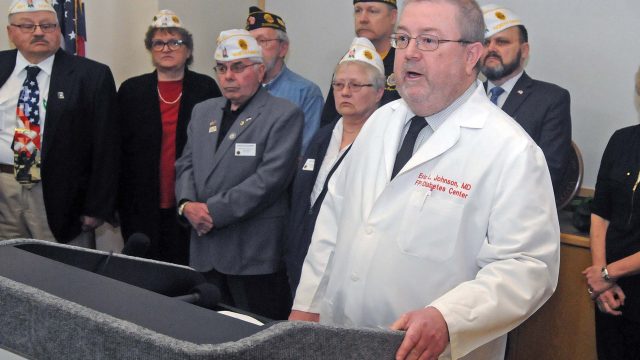Should Smoking And Vaping Be Treated As Though They're Exactly The Same?

TOM STROMME/Tribune Eric Johnson, of Grand Forks, speaks at a press conference announcing the Raise It For Health North Dakota coalition's introduction of an initiated measure to raise tobacco taxes in the state. The group plan to have the petitions signed to get the measure on the November ballot.
Should we regulate and tax vaping products in the exact same manner as we do tobacco products?
That’s likely going to be the question before North Dakota voters this year as anti-tobacco activists push a new ballot measure (read it at the link). Their proposal would lump vaping products in with tobacco products, and then implement massive tax hikes on both (about a 400 percent increase for cigarettes, about a 100 percent increase for other tobacco products).
In a letter to the Grand Forks Herald last week, Dr. Eric Johnson (who is chairing the ballot measure committee) defended his measure by suggesting that it only seeks to treat vaping the same as smoking.
“[T]he measure will treat the liquid nicotine drug (smoked via electronic cigarettes) and those who sell it exactly the same as all other tobacco products,” he writes.
That’s going to be the crux of this debate, I think. Regrettably, most North Dakotans would likely back a tax hike on tobacco, because most North Dakotans don’t use the stuff. Nor do they sell it. Thus a tax hike, even a big one, is no big deal to them.
But more controversial, I think, is this idea that vaping should be lumped in with smoking for the purposes of tax and regulatory policy.
The problem is that vaping isn’t smoking. Even anti-tobacco zealots like Johnson are forced to acknowledge this, which he does obliquely in this report from Herald reporter John Hageman:
Johnson said electronic cigarettes are not FDA-approved as smoking cessation devices and there isn’t sufficient evidence that they help people quit traditional cigarettes. Indeed, a study published in the Lancet Respiratory Medicine in January found adult smokers who use e-cigarettes were less likely to quit smoking, according to CBS News.
“If they had data, I would recommend them just like any other stop-smoking product,” Johnson said. “Since we don’t really know whether these help or promote use, it’s very difficult as a health care provider to recommend them at this time.”
Moreover, Johnson is worried that they act as a gateway for young people to move on to other tobacco products. While the percentage of North Dakota high school students who smoke has dropped substantially over the past 20 years, roughly 20 percent of Grand Forks students use electronic vapor products, according to survey results previously provided by the Grand Forks Public Health Department.
There seems to be a lot Johnson doesn’t know about vaping. And yet he’s willing to support a massive tax hike for vaping products anyway.
“The e-cig vape technology, they’re tobacco products by about just any medical definition,” Johnson says elsewhere in the article, but his comments in the blockquote above disprove that statement.
Vaping clearly is not a tobacco product like those we’re traditionally used to seeing. It’s a product that can serve as a healthier (if not altogether healthy) alternative to smoking.
Isn’t that a public health victory? Shouldn’t even Johnson admit that a transition from smoking to vaping is probably a net gain in terms of public health?
What worries me is that we have so entangled anti-tobacco activism with the government’s public health mechanisms that this sort of a point gets lost. During the 2008 cycle North Dakota voters approved Measure 3, pouring the state’s share of tobacco settlement dollars into a new state agency you know as BreatheND. Which is less a public health agency than an advocacy organization.
Now, because the mission has morphed from public health to political advocacy, these political activists seem intent on taxing-and-regulating to death a healthier alternative to smoking.
That may satisfy the desires of indiscriminate anti-tobacco zealots, but it’s hardly what’s best for the public.




